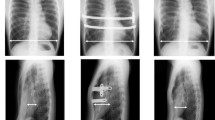Abstract
In this study, we present finite element analysis models to calculate the increase in intrathoracic volume of pectus excavatum patients after the Nuss procedure. One virtue of our approach is that the measurement of the intrathoracic volume has no time difference and is not affected by postoperative pain, which cannot be achieved with a 2-year difference between pre- and postoperative pulmonary function testing or any other clinical method. The calculations show that the intrathoracic volume of pectus excavatum patients increased by approximately 2.72–8.88% after the Nuss procedure. The increment curve was patient-dependent, although the increment behavior was similar among the six patients examined. The curve of the increase became flat when the elevating force exceeded 80 N or the displacement of the lower sternal end exceeded 2.6 cm in half of our cases.



Similar content being viewed by others
References
Chang PY, Lai JY, Chen JC et al (2006) The long-term changes of the bone and cartilage after Ravitch’s thoracoplasty: identification with multislice CT with 3D reconstruction. J Pediatr Surg 41:1947–1950
Chang PY, Hsu ZY, Chen DP et al (2008) Preliminary analysis of the stress and strain generated on thoracic cage of pectus excavatum patients after Nuss procedure. Clin Biomech 23:881–885
Feng J, Hu T, Liu W et al (2001) The biomechanical, morphologic, and histochemical properties of the costal cartilages in children with pectus excavatum. J Pediatr Surg 36:1770–1776
Fonkalsrud EW (2003) Current management of pectus excavatum. World J Surg 27:502–508
Fonkalsrud EW (2004) Open repair of pectus excavatum with minimal cartilage resection. Ann Surg 240:231–235
Fonkalsrud EW, Reemtsen B (2002) Force required to elevate the sternum of pectus excavatum patients. J Am Coll Surg 195:575–577
Haller JA Jr et al (1987) Use of CT scans in selection of patients for pectus excavatum surgery: a preliminary report. J Pediatr Surg 22:904–906
Kliegman RM, Behrman RE, Jenson HB et al. (2007) Pulmonary function testing. Nelson textbook of pediatrics, 18th edn. Saunders, Philadelphia, pp 1733–1734
Lawson ML, Mellins RB, Tabangin M et al (2005) Impact of pectus excavatum on pulmonary function before and after repair with the Nuss procedure. J Pediatr Surg 40:174–180
Malek MH, Fonkalsrud EW, Cooper CB (2003) Ventilatory and cardiovascular responses to exercise in patients with pectus excavatum. Chest 124:870–872
Mueller C, Saint-Vil D, Bouchard S (2008) Chest X-ray as a primary modality for preoperative imaging of pectus excavatum. J Pediatr Surg 43(1):71–73
Nuss D, Kelly RE, Croitoru DP et al (1998) A 10-year review of a minimally invasive technique for the correction of pectus excavatum. J Pediatr Surg 33:545–552
Quigley PM, Haller JA, Jelus KL et al (1996) Cardiorespiratory function before and after corrective surgery in pectus excavatum. J Pediatr 128:638–643
Weber PG, Huemmer HP, Reingruber B (2006) Forces to be overcome in correction of pectus excavatum. J Thorac Cardiovasc Surg 132:1369–1373
Yang KH, Wang KH (1998) Finite element modeling of the human thorax. Presented at the second visible human project conference, Bethesda, MD, USA, 1–2 Oct 1998
Acknowledgments
This study was supported by the National Center for High-Performance Computing (NCHC), Hsinchu, Taiwan. The authors sincerely thank Dr. Lun-Jou Lo at Chang Gung Memorial Hospital (Taoyuan, Taiwan, ROC) for his assistance in creating the finite element models reported herein.
Author information
Authors and Affiliations
Corresponding author
Rights and permissions
About this article
Cite this article
Chang, PY., Hsu, ZY., Lai, JY. et al. Increase in intrathoracic volume in pectus excavatum patients after the Nuss procedure. Med Biol Eng Comput 48, 133–137 (2010). https://doi.org/10.1007/s11517-009-0570-9
Received:
Accepted:
Published:
Issue Date:
DOI: https://doi.org/10.1007/s11517-009-0570-9




